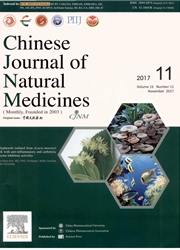

 中文摘要:
中文摘要:
The present study was designed to target fish for potential bioactive components contained in a Huang Lian Jie Du decoction(HLJDD) and identify the underlying mechanisms of action for the treatment of sepsis at the molecular level. he bioactive components database of HLJDD was constructed and the sepsis-associated targets were comprehensively investigated. The 3D structures of the PAFR and TXA2 R proteins were established using the homology modelling(HM) method, and the molecular effects for sepsis treatment were analysed by comparing the bioactive components database and the sepsis targets using computational biology methods. The results of the screening were validated with biological testing against the human oral epidermal carcinoma cell line KB in vitro. We found that multiple bioactive compounds contained in the HLJDD interacted with multiple targets. We also predicted the promising compound leads for sepsis treatment, and the first 28 compounds were characterized. Several compounds, such as berberine, berberrubine and epiberberine, dose-dependently inhibited PGE2 production in human KB cells, and the effects were similar in the presence or absence of TPA. This study demonstrates a novel approach to identifying natural chemical compounds as new leads for the treatment of sepsis.
 英文摘要:
英文摘要:
The present study was designed to target fish for potential bioactive components contained in a Huang Lian Jie Du decoction (HLJDD) and identify the underlying mechanisms of action for the treatment of sepsis at the molecular level, he bioactive components database of HLJDD was constructed and the sepsis-associated targets were comprehensively investigated. The 3D struc- tures of the PAFR and TXA2R proteins were established using the homology modelling (HM) method, and the molecular effects for sepsis treatment were analysed by comparing the bioactive components database and the sepsis targets using computational biology methods. The results of the screening were validated with biological testing against the human oral epidermal carcinoma cell line KB in vitro. We found that multiple bioactive compounds contained in the HLJDD interacted with multiple targets. We also predicted the promising compound leads for sepsis treatment, and the first 28 compounds were characterized. Several compounds, such as berberine, berberrubine and epiberberine, dose-dependently inhibited PGE2 production in human KB cells, and the effects were similar in the presence or absence of TPA. This study demonstrates a novel approach to identifying natural chemical compounds as new leads for the treatment of sepsis.
 同期刊论文项目
同期刊论文项目
 同项目期刊论文
同项目期刊论文
 期刊信息
期刊信息
